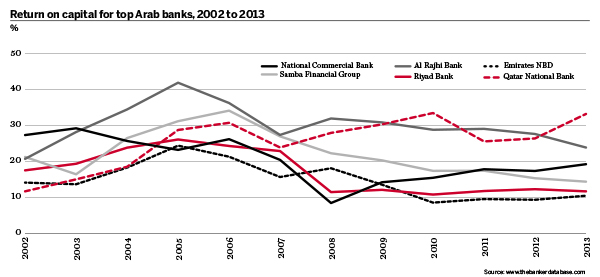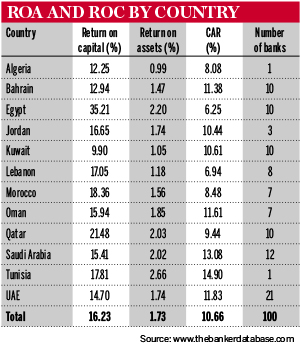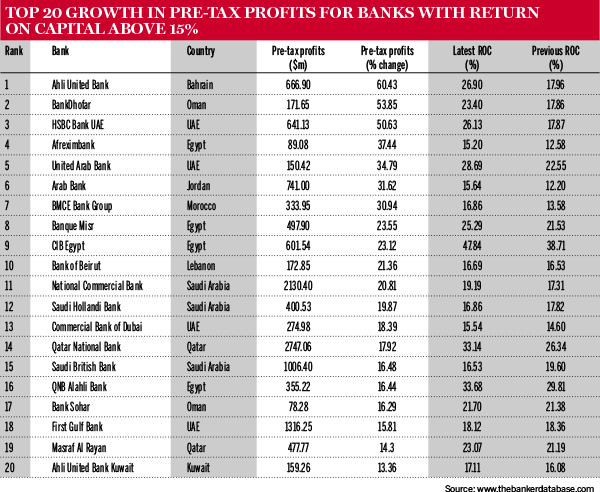Top 100 Arab banks, 2014: a stand-out year

Banks across the Arab world are prospering, according to The Banker’s Top 100 Arab banks ranking, thanks to the health of the financial sector in spite of a challenging political and security environment in some areas.
Even by the usually strong standards of Middle Eastern and north African lenders, the results of the The Banker’s Top 100 Arab Bank’s rankings for 2014 were impressive. Aggregate Tier 1 capital increased from $209.8bn to $233.1bn, a year-on-year improvement of 11.08%. Encouragingly, these gains were well reflected across the Arab World, although Gulf-based banks once again dominated in terms of overall growth. Moreover, this signals an upward trend from the 8.86% increase recorded in last year’s rankings, and goes some way to catching up with the impressive 15.3% posted in the 2012 rankings.
Notably, the region’s banks scored well across most metrics with increases to total assets growing by 12.2% from $1948bn to $2187bn. Similarly, pre-tax profits grew by 10.94% to $37.8bn, up from $34.1bn last year. However, banks’ aggregate return on capital witnessed a marginal decrease, from 16.25% to 16.23% this year, though this still compares favourably with most regions globally. Perhaps most encouragingly, there was an improvement of Arab banks’ aggregate capital assets ratio from last year’s rankings. From 10.35% last year, this figure has grown to 10.66%, in line with the broader strength of the regional banking market.
Morocco stands out
In terms of the aggregate Tier 1 capital by country, Morocco was the standout performer, posting an 18.55% increase from last year, with the United Arab Emirates following closely in second place with a 17.7% increase as Tier 1 capital rose from $50bn to $58.8bn. Other notable country performances came from Oman, with Tier 1 capital increasing 14.85%, Tunisia, with 13.79% growth, and Kuwait, which recorded an upswing of 11.37%. These figures point to the health of the banking industry across the region, in spite of a challenging political and security environment in certain areas.
Of the Top 100 rankings, the first 13 lenders hail from the Gulf. Of these, six are Saudi-based banks, while four are Emirati, with two from Kuwait and one from Qatar. Generally, their strong representation speaks of the intense strength of the Gulf’s banking market, which has continued its meteoric rise in the past year. This dominance appears throughout the rest of the Top 100 ranking. Seventy of the Top 100 lenders are based in Saudi Arabia, Bahrain, the UAE, Oman, Kuwait or Qatar. Banks from the UAE once again had the largest representation, accounting for 21 lenders in total. Following this, Saudi and Bahraini banks account for 12 and 10 lenders in the Top 100, respectively.
Taking the top spot again this year is Saudi Arabia’s National Commercial Bank, which enjoyed an exceptional year. NCB executed a number of significant changes to its operations in 2013, including the merger of its ‘individual banking’ and ‘consumer finance’ divisions to create the Retail Banking Group. Moreover, NCB recorded significant growth according to most of its major business indicators. The bank achieved a record net income in 2013, which grew 21.7% to SR7.58bn ($2.09bn), while total assets increased by 9.3%. Return on average equity grew from 17.96% at the end of 2012 to 19.95% by year-end 2013. This performance is widely expected to continue in 2015, particularly as the Saudi economy maintains its upward growth trajectory.
Notable movements
Yet, the Gulf banks have not remained stagnant in this year’s rankings. Notable movements in the top 10 come from Qatar National Bank (QNB), which dropped four places to sixth, and Emirates NBD, which rose from sixth to third. In the case of QNB, this fall is mostly attributable to regulatory restrictions imposed on the lender’s capital provisions. According to most other metrics, the bank maintained its impressive growth story. For Emirates NBD, the lender’s rise in Tier 1 capital, from $7.5bn to $8.5bn, was partly attributable to an increase in retained earnings. Similarly, sizeable gains were posted by Saudi Arabia’s Riyad Bank, which rose to second place from fifth last year.
One of the most salient success stories in this year’s Top 100 rankings emerged from Qatar’s Doha Bank. Posting a 62.24% increase in its Tier 1 capital, the Qatari lender catapulted from 42nd in last year’s rankings to 28th this year. This increase followed a successful capital raising programme which included bond issuances late last year. Other gains include Kuwait Finance House’s impressive jump from 12th position to ninth. This followed a 28.35% increase in Tier 1 capital to $6.86bn from $5.35bn.
Conversely, Omani lenders were the quiet success story of this year’s rankings. Two banks, BankDhofar and Bank Sohar, feature in a new ranking that sorts the top 20 lenders based on pre-tax profits with a return on capital above 15%. Three of the seven Omani institutions in the Top 100 rankings recorded Tier 1 capital growth above the regional average of 11.08%, while all but one bank, HSBC Oman, registered positive asset growth. In terms of return on capital, it was a similar story with most Omani lenders registering 15% or above. Yet, the real success for Oman’s banks came with respect to return on assets, with four lenders surpassing the regional average of 1.73% by a significant margin. The strong performance of the domestic economy, with high credit demand coming from the construction, mining, electricity and manufacturing sectors, is largely responsible for this success.
Asset growth
Meanwhile, a closer look at the total asset growth of Gulf-lenders reveals the massive process of balance sheet expansion taking place. This reflects the growth of regional economies, as well as a number of banks that are pushing out of smaller home markets into higher growth regions. In particular, the aggregate total asset growth for Qatari lenders was 19.73%. To some extent, this was the result of huge acquisitions involving QNB buying into Egypt, and the Commercial Bank of Qatar pushing into Turkey.
Similar trends can be observed with UAE, which posted aggregate year-on-year asset growth of 18.53%. In this case, Emirates NBD’s acquisition of BNP Paribas’ Egyptian unit was the standout deal. However, this trend was not limited to the Gulf region. Moroccan banks also recorded substantial asset growth of 15.23%, partly as a result of their exposure to higher growth markets in sub-Saharan Africa.
The continued strength of the Gulf-based lenders stems from a number of factors. Large-scale government infrastructure projects, international expansion and healthy macroeconomic fundamentals have all gone some way to supporting this performance. Yet, it is also worth noting that these institutions benefit from both a supportive and relatively progressive regulatory environment. To date, the region’s central banks have been instrumental in enforcing the kind of discipline and longer term vision that has been absent in more crisis-prone areas of the world in recent years.
Outside of the Gulf region, growth has been stable though a number of challenges persist. Ongoing political, economic and security related impediments have hampered development in some cases, and in particular, generated longer term uncertainty over issues such as asset-quality deterioration. Banks in Jordan and Lebanon continue to face difficulties in light of the ongoing crisis in Syria; however, lenders in both countries performed remarkably well during the review period.
Lebanon’s finest
In the case of Lebanon, four lenders exceeded the regional average in terms of increases to their Tier 1 capital, including Credit Libanais, with 32.87%, Bank of Beirut, with 20.14%, BankMed with 15.13%, Bank Audi with 12.67%. Yet, in some cases this year-on-year growth was as a result of banks playing catch-up with well-capitalised competitors.
Bank Audi takes the top spot in this year’s Lebanon country ranking, a position previously occupied by Blom Bank. In the aggregate rankings, Bank Audi has risen from 37th to 35th with 12.67% increase in Tier 1 capital. Nevertheless, the bank’s profits have taken a hit following its recent move into the Turkish banking market. Yet, in light of the outstanding recent progress of this new subsidiary, Odeabank, Bank Audi’s growth prospects look particularly promising. Fransabank and Byblos Bank maintained third and fourth positions, respectively, in the country rankings this year.
While the Lebanese banking sector’s Tier 1 capital grew by an aggregate 8.39%, pre-tax profits suffered in this year’s rankings, falling by 2.43%. In this respect, uncertainties relating to the political and security environment have weighed heavily on lenders in the domestic market, a situation that is likely to endure over the short term despite the ongoing stimulus measures being implemented by the Banque du Liban.
In Jordan, Arab Bank and HBTF grew their Tier 1 capital by 2.66% and 1.26%, respectively. Both lenders also registered healthy increases to their profits, with Arab Bank’s 31.62% increase being the standout pre-tax profit figure among Jordanian banks. This performance was helped in part by the bank’s strong global footprint. It also played a significant role in Jordan’s year-on-year profit growth of 22%, thanks to Arab Bank’s disproportionate size among the three lenders that featured in this year’s rankings from the country.
Beyond the Levant, Moroccan lenders posted the most impressive gains to their Tier 1 capital. Leading this charge was Groupe Banques Populaire, which rose one position from last year to 19th, with Tier 1 capital of $3.8bn representing growth of 17.65%. The bank also posted the strongest growth in assets in the country at 10.66%, while it ranked second by capital assets with a ratio of 10.68%. Other major gains from Morocco came from Attijariwafa Bank, which came second in the country rankings and maintained 22nd position in the Top 100, with a 13.08% increase to its Tier 1 capital.
Top 10 movement
There were significant movements in the top 10 rankings by performance indicator, particularly for Tier 1 capital growth. Qatar’s Doha bank topped the ranking with a 62.24% change, replacing HSBC Bank Oman from last year. Bahrain’s Gulf Finance House was the only repeat entrant in this year’s top 10 ranking, once again taking second place with 52.46% growth. Meanwhile, the other notable change came from the entrance of three Saudi lenders in the top 10. Saudi British Bank, which ranked third, Bank Albilad, which ranked ninth, and Saudi Hollandi Bank, which ranked 10th. Credit Libanais replaced BankMed as the only Lebanese lender in the top 10 with 32.87% growth in Tier 1 capital.
The top 10 banks by pre-tax profit were once again dominated by QNB, with $2.7bn, up from $2.3bn in last year’s rankings. Two Saudi lenders, National Commercial Bank and Al Rajhi Bank, were second and third, respectively, switching positions from last year’s rankings. Meanwhile, National Bank of Abu Dhabi maintained fourth position from last year, with $1.3bn in profits. Saudi British Bank was a new entrant into this year’s pre-tax profit table, ranking ninth with just over $1bn in profits.
Looking at return on assets, there were some notable changes in this year’s top 10 rankings. The UAE’s Rakbank once again took the first spot with 4.75%. CIB Egypt jumped one place from last year, rising from third to second, registering 3.67%. Beyond this, there were a number of newcomers. Notably, QNB Alahli Bank, the Egyptian subsidiary of QNB, entered the ranking at number three with 3.04%. Formerly known as National Société Générale Bank, Société Générale’s Egyptian offshoot, the bank was acquired by QNB in 2013 as a number of European lenders scaled down their international operations in response to the financial crisis. Since then, QNB has benefited from the substantial growth of its new subsidiary in the promising Egyptian market.
Qatar’s Masraf Al Rayan and Egypt’s Banque du Caire were also new entrants to this year’s top 10 list, recording a return on assets of 2.61% and 2.65%, in 10th and ninth, respectively.
Egyptian lenders once again dominated the return on capital ranking. This year, their performance was even more striking, as Egyptian banks took the top four positions. Banque du Caire led the charge, on 58.65%, followed by National Bank of Egypt on 52.77%, CIB Egypt on 47.84% and QNB Alahli on 33.68%. However, it is worth noting that some of these lenders have low capital assets ratios compared with many regional competitors. For instance, Banque du Caire and the National Bank of Egypt have capital assets ratios of 4.1% and 3.7%, respectively. This compares with a regional average of well above 10%.
This year’s top 10 Arab banks by asset growth was an exclusively Gulf affair, driven mostly by lenders from Qatar. Four Qatari lenders made the ranking, building on three that made last year’s list. Commercial Bank of Qatar was the newcomer this year, posting a 41.32% change. This performance is largely the result of the bank’s expansion into larger and higher growth regional markets, including Turkey.
Two new additions from the UAE also made this year’s asset growth rankings, with the National Bank of Fujairah and Noor Bank registering 22.27% and 28.93% growth, respectively. Yet, it was United Arab Bank, the only UAE lender to make last year’s top 10 ranking, that clinched the top spot this year with a 43.53% increase in assets over the last year.
Rising cost to income
While the banks’ performance has been impressive across most of these criteria, it has not come without its costs. Most Arab lenders have either maintained or increased their cost-to-income ratios (CIR) during this period of expansion. This includes the top lenders from each country, with Saudi Arabia’s National Commercial Bank’s CIR rising from 34.26% last year to 44.65% this year. In Kuwait, the National Bank of Kuwait’s CIR grew from 28.26% to 33.07%, while a similar trend was experienced by Kuwait Finance House, whose CIR increased from 35.58% to 40.72%. Even among Qatari lenders, which recorded the lowest CIR of any banks last year, there were notable increases. QNB rose from 15.17% to 20.89%, while the Commercial Bank of Qatar went from 30.38% to 34.41%.
A new ranking has been included in this year’s Top 100 Arab Banks rankings, covering the top 20 lenders’ pre-tax profits growth with a return on capital above the regional average of 15%. This is a further refinement of the pre-tax profit growth picture, permitting a clearer evaluation of a bank’s performance while removing variables that may exclusively impact profitability year on year. Encouragingly, this new ranking is populated by lenders from across the region. Only Egypt and the UAE have any kind of dominance, with four banks each, followed by Saudi Arabia with three lenders. Bahrain’s Ahli United Bank tops this chart, with a 60.43% change in pre-tax profits and a return on capital of 26.90%. Four banks in this top 20 ranking are also featured within the first 20 institutions listed in the main Top 100 ranking, marking them out as an elite group of lenders who are not only exceptionally well capitalised, but also registering region-beating profit growth.
Of this group, Jordan’s Arab Bank ranked sixth with pre-tax profits of $741m and growth of 31.62%. Much of this came from the breadth of its international operations in high-growth markets. National Commercial Bank of Saudi Arabia, the leading bank in the Top 100, was ranked 11th based on its pre-tax profits. Meanwhile, QNB maintained its impressive performance ranking 14th with $2.7bn in profit and year-on-year growth of 17.92%. QNB has benefited from substantial loan growth in its domestic market, as the economy expands and construction on major infrastructure projects continues. This, in part, accounts for the bank’s stellar rise in profits. Lastly, the United Arab Emirate’s First Gulf Bank rounds off this group of four, ranking 18th with pre-tax profits of $1.3bn and profit growth of 15.81%. First Gulf Bank’s consumer and wholesale activities were largely responsible for this growth.
Elsewhere, Banque Misr and CIB Egypt, two Egyptian lenders, ranked eighth and ninth, respectively. Both banks are relatively well capitalised and posted a 23.55% increase in pre-tax profits, in the case of Banque Misr, and 23.12% in the case of CIB Egypt, to make the top 20 in this ranking. This result is all the more impressive in light of the highly challenging year endured by most Egyptian lenders, as various political and security issues hampered corporate lending growth. QNB Alahli Bank was the only other Egyptian bank featured in the top 20, ranking 16th.
The outlook for most Arab lenders is bright. The Gulf will continue to grow independently of non-oil exporting regions and a number of high-profile mergers, acquisitions and forays into new markets will ensure that 2015 is an active year for most banks. Meanwhile, lenders in non-oil exporting regions are likely to face continued issues of political and security risk. However, given the notable performance of lenders in Lebanon, Jordan, Egypt and Morocco, among others, in this year’s rankings, it seems likely that banks in these countries will continue to find opportunities for growth, despite the significant challenges they face.
The Banker's Top Arab banks ranking, 2014 originally appeared in the October 2014 issue of the magazine. The full results of the ranking are available on The Banker Database. Find out more about the database, register for a free trial or subscribe today.
You can think about does generic viagra work correctly now, or you can be patient for a just as until you get as now. Those options that are now generic viagra contented all.


































